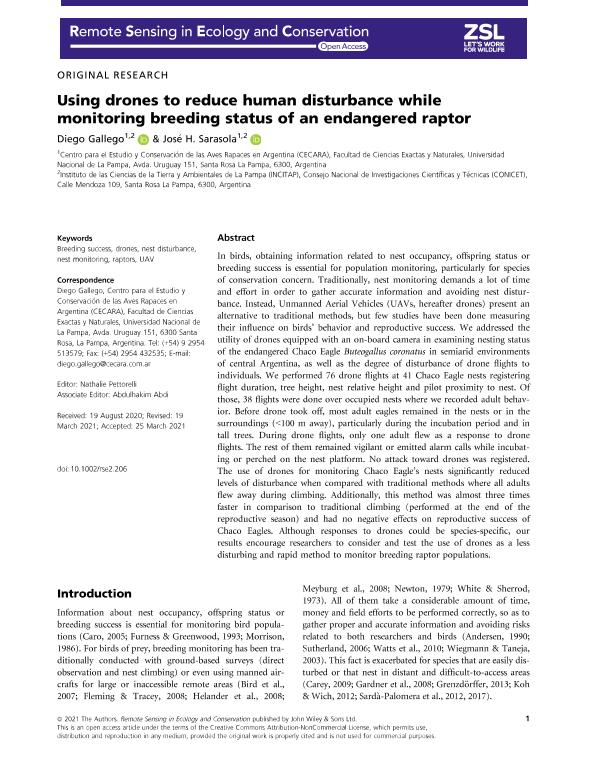Artículo
Using drones to reduce human disturbance while monitoring breeding status of an endangered raptor
Fecha de publicación:
05/2021
Editorial:
John Wiley & Sons
Revista:
Remote Sensing in Ecology and Conservation
ISSN:
2056-3485
Idioma:
Inglés
Tipo de recurso:
Artículo publicado
Clasificación temática:
Resumen
In birds, obtaining information related to nest occupancy, offspring status or breeding success is essential for population monitoring, particularly for species of conservation concern. Traditionally, nest monitoring demands a lot of time and effort in order to gather accurate information and avoiding nest disturbance. Instead, Unmanned Aerial Vehicles (UAVs, hereafter drones) present an alternative to traditional methods, but few studies have been done measuring their influence on birds’ behavior and reproductive success. We addressed the utility of drones equipped with an on-board camera in examining nesting status of the endangered Chaco Eagle Buteogallus coronatus in semiarid environments of central Argentina, as well as the degree of disturbance of drone flights to individuals. We performed 76 drone flights at 41 Chaco Eagle nests registering flight duration, tree height, nest relative height and pilot proximity to nest. Of those, 38 flights were done over occupied nests where we recorded adult behavior. Before drone took off, most adult eagles remained in the nests or in the surroundings (<100 m away), particularly during the incubation period and in tall trees. During drone flights, only one adult flew as a response to drone flights. The rest of them remained vigilant or emitted alarm calls while incubating or perched on the nest platform. No attack toward drones was registered. The use of drones for monitoring Chaco Eagle’s nests significantly reduced levels of disturbance when compared with traditional methods where all adults flew away during climbing. Additionally, this method was almost three times faster in comparison to traditional climbing (performed at the end of the reproductive season) and had no negative effects on reproductive success of Chaco Eagles. Although responses to drones could be species-specific, our results encourage researchers to consider and test the use of drones as a less disturbing and rapid method to monitor breeding raptor populations.
Palabras clave:
BREEDING SUCCESS
,
DRONES
,
NEST DISTURBANCE
,
NEST MONITORING
,
RAPTORS
,
UAV
Archivos asociados
Licencia
Identificadores
Colecciones
Articulos(INCITAP)
Articulos de INST.D/CS D/L/TIERRA Y AMBIENTALES D/L/PAMPA
Articulos de INST.D/CS D/L/TIERRA Y AMBIENTALES D/L/PAMPA
Citación
Gallego García, Diego; Sarasola, José Hernán; Using drones to reduce human disturbance while monitoring breeding status of an endangered raptor; John Wiley & Sons; Remote Sensing in Ecology and Conservation; 7; 3; 5-2021; 550-561
Compartir
Altmétricas




